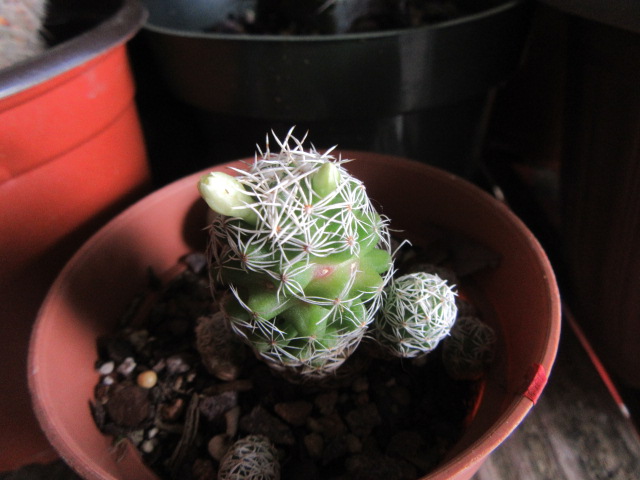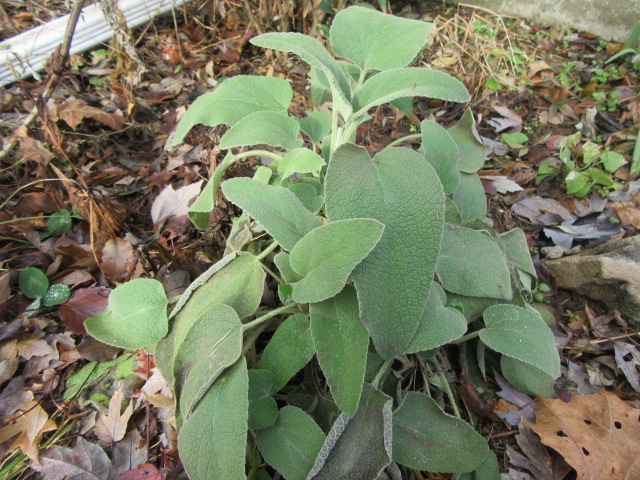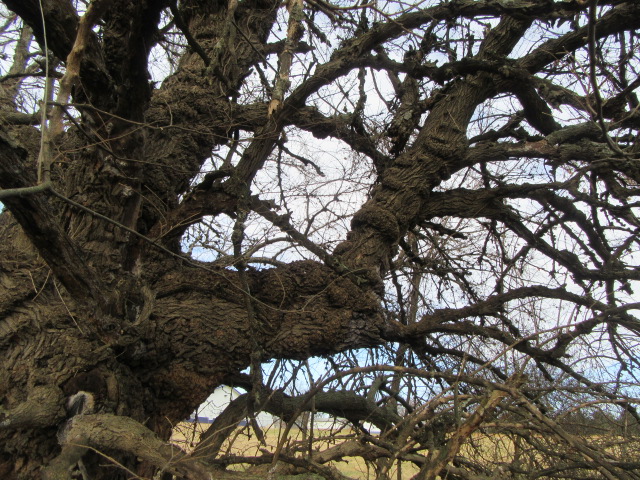
Hello everyone! I hope this post finds you all well. This is my second attempt to make a Six on Saturday post. Jade was looking out the window and I told her I was going to take a few photos for a Six on Saturday post. She said, “good luck with that.” When I came back inside and found there were photos of eight I decided to not include the photo of Jade in the six (although the photo is clearly here). Then I deleted the photo of the Equisetum so I wouldn’t accidentally include it.

Mammillaria karwinskiana (Silver Arrows) flowers on 11-23-19.
#1) I wanted to make a post about the Mammillaria karwinskiana (Silver Arrows) since all the buds were fully opened. I decided including it in this post would be appropriate and was glad they were still looking good this morning. There are a couple of buds on the other side.

Mammillaria vetula subsp. gracilis buds on 11-23-19.
#2) I looked around a bit to see if there was anything else that was exciting then I noticed the little Mammillaria vetula subsp. gracilis (Thimble Cactus) had a couple of buds. That may not sound exciting, but I thought it was. For this plant to be so small and have two buds… Yeah, that is exciting!
I could have easily found all six items to post about inside, but I went outside to see what I could find. It was 37° F and it had rained during the night.

#3) I finally filled the feeder hanging in a maple tree in the front yard yesterday. Although there are very few birds here right now, I saw a group of sparrows in a bush that seemed to be hungry. They were no doubt waiting for me to fill the feeder in “the other yard”, which I did. This morning while taking the photos I saw the “other feeder” was empty already so probably the deer found it during the night. Maybe I am anxious, but it seems the birds are late arriving this Fall.

Phlomis ‘Edward Bowles’ on 11-23-19.
#4) The Phlomis ‘Edward Bowles’ is still alive and well. I did make a note to cover it when nighttime temps dipped a few days ago even though it has proved it didn’t need it. I have a sticky note stuck to the computer that reminds me. 🙂

#5) The old Mulberry tree in an area along the boundary fence behind the chicken house is always worthy of attention. It would be great to know how old it really is.

It is very gnarly and was a very old tree when I was a kid. Sometimes I sit next to this tree, with my back against it and it seems I can feel its energy. A very good place to meditate.

It is by far not the biggest Mulberry tree here now because age has taken a toll on this tree. It has survived many lightning strikes, heavy winds, ice, snow, drought and so on for MANY years. I remember as a kid when I was in the barn with my grandpa as we watched lightning strike an old tree along the fence. I call this the elder tree and hope it has many more years to come.

#6) Hmmm… Could it be? If so, I am shocked I missed it before! This is definitely a species of Physalis (Ground Cherry, Japanese Lantern) and likely it is Physalis longifolia. When I was at Kevin’s farm this past summer I spotted a single Physalis longifolia in the pasture. The plant there was similar in size to the Solanum (Horsenettle) species because it had no doubt been nibbled on by the cows. So, when I looked for it here in the pastures I was looking for a smaller plant similar to the Horsenettle with yellow flowers.

Well, this dead plant is 31″ tall… I checked with the Missouri Plants website and read where Physalis longifolia can grow to 3 meters, which I must have ignored earlier. Missouri Plants lists six species of Physalis.

Common names for Physalis longifolia include Long-Leafed Ground Cherry, Longleaf Ground Cherry, Wild Tomato, and Common Groundcherry.
To think I had been looking for this plant during the summer only to find it NOW when it is all dried up. GEEZ!!! I found it not in the pasture, but on my way back from photographing the old Mulberry tree… Among other tall weeds. You can bet I will have my eye on this area next summer! Hopefully at least one will come up so I can make a proper ID. 🙂
Well, that’s it for my attempt for a Six on Saturday post. Remember, Jade doesn’t count…
If you wish to participate in Six on Saturday posts, be sure to read the Six On Saturday-a participants guide from The Propagator.
That blooming cactus is gorgeous. So is your kitty.
LikeLiked by 1 person
Hello Lisa! The cactus is definitely nice. I will not tell Jade you said she is gorgeous because she already thinks so. Thanks for the comment!
LikeLike
I read this…”White mulberry trees have been known to live for more than 100 years while red mulberry trees rarely live more than 75 years.” Your tree looks very old. The ones in the woods behind our house are dying for some reason.
LikeLiked by 1 person
Hello Jim! I am almost 59 and that tree was old when I was a kid. There are two other old trees that I don’t remember as a kid in the front pasture. There is one in the southeast pasture by the swamp that is incredibly tall. There are MANY other Mulberry trees, both red and white, in the fence rows and on the pond banks. Are the trees that are dying behind your house old or young trees? Maybe there is a problem and you should mention it to the conservation department. How long have you noticed this? Thanks for the comment!
LikeLike
They are older. The ground they’re on was disturbed by developers years ago and started their demise. Others farther into the woods are fine.
Some of my best memories as a kid are from trees on our farm.
LikeLiked by 1 person
Ahhh… I have a lot of tree memories as well. 🙂
LikeLike
The flowers on the cactus are so beautiful! I have many mulberry trees and not one looks like that one! How unique and old it is and that is has such wonderful memories for you.
LikeLiked by 1 person
Hello Diane! I am glad I have several Mammillaria species now that have flowers of different colors besides pink. This old Mulberry has probably grown like that because of being struck by lightning and surviving. It is the only one here that looks like that, too. It is quite a tree. Thanks for the comment!
LikeLiked by 1 person
I’m in love w/your mulberry tree. I’m certain you do feel its energy & it feels yours as well. When you showed Japanese lantern growing wild in the field, I had to do a little bit of stalkery to see where you’re located. I hadn’t a clue they grew wild in the western US states. Were they escapees from domestic gardens or native plants? (Love the cacti, too.)
LikeLiked by 1 person
Hello Lora! I am glad you like the old Mulberry. It is indeed a magnificent tree. The plant in question is likely Physalis longifolia which WAS in the same genus as the Japanese/Chinese Lantern. After you made the comment, I decided to do a little checking myself. The scientific name for the Japanese/Chinese Lantern is/was Physalis alkekengi but Plants of the World Online says the name has changed to Alkekengi officinarum. Of course, that may not be completely official as one of the key people did not accept the name change… Perhaps the change was due to genetic testing. It had this name before, among others. The Missouri Botanical Garden says Physalis alkekengi is a herbaceous perennial and is hardy in USDA Zones 3-9. The USDA map shows it as a Missouri native but I haven’t seen it listed as such in any Missouri native plant databases. I will have to wait until next year to see if it returns to make a better ID. Thanks for the comment!
LikeLike
I find the changing of plant names most inconsiderate of my short term memory. Hail to the one person who objected! (even if, as you say, it was genetically determined.) Interesting that Missouri doesn’t claim it, but the USDA says it’s yours. Curious, how those determinations are made. Thanks so much for looking that up. Quite interesting!
LikeLiked by 1 person
It is native of Southern Europe, South and Northeast Asia. It is possible it is in Steyermark’s Flora of Missouri but I didn’t check when I rented the booksfrom the library. It is one of those species that have been introduced to or escaped people’s gardens to naturalize in other countries. You would be surprised at how many native species are escapees. Name changes are necessary because so many plants have multiple scientific names having been “discovered” by many plant explorers. Other names were given by botanists because they thought they should be in ther genera. It is a very complicated process and rules have to be followed when giving plants names. Even though rules were followed, some plants wound up with multiple names. Some species are quite variable from one location to another and may appear different which is how the varieties and subspecies come about. Testing has been helpful, but it has a tendency to eliminate the variety or subspecies names which drives me nuts! I think, since they are different and reproduce differently than the “original” variety, the variety and subspecies names should be accepted. In my blog, you will see often I continue to use those names to distinguish plants. That is allowed as long as the name was validly published. 🙂
LikeLiked by 1 person
I love your mulberry tree. I’ve got one, mine is about 46 years old, my late mother-in-law gave it to me when we moved to this house. It would be massive but I regularly pollard it and that keeps it under control. And I get straight long branches I can use instead of buying bamboo sticks for growing climbing beans. The birds get the fruit but I don’t mind.
LikeLiked by 1 person
Hello Helen! Good idea to keep large trees at bay sometimes. Glad you have found a good use for the branches. Many people use branches like that for pole beans instead of buying bamboo. There are usually ample berries for the birds and other wildlife. Sometimes the Amish come and get some of the berries for jelly. Thanks for the comment!
LikeLiked by 1 person
Physalis is an odd one. I had never met it before, when I client showed me some in his vegetable garden. they were grown as if they were tomatoes. He ordered the seed from Italy, and explained that in other part of the world, they are quite popular. He even gave me some of the seed, which I never grew.
LikeLiked by 1 person
Hello Tony! The Physalis species are indeed odd. There are plants in other genera that the same strange “baloon” over the fruit. I am very anxious to see if more will come up this spring. Thanks for the comment!
LikeLiked by 1 person
The client who shared his seeds with me had planted new ones earlier in the year, but also overwintered his older plants somehow. That appealed to me. Not only did the original plant regenerate from the roots, but a few stems were layered around it. Of course, they were garden varieties rather than a wild sort.
LikeLiked by 1 person
Many of them are perennial. Even the species Physalis longifolia in the pasture are perennial.
LikeLiked by 1 person
I think that if I grew the edible types, I would prefer to grow them as perennial, even if I replaced old plants with layered stems every so often.
LikeLiked by 1 person
I hope your cacti survive the winter – a fair few specimens I’ve never seen before. I can’t remember the names but the one which looked like it had a number of flappy ears was most charming!
Anyway, I hope you remember where the ‘Japanese lanterns’ (if I’ve got the name right) are next year. They look lovely as well.
There probably is a way to have the mulberry dated but I guess it would cost an arm and a leg 😉
LikeLiked by 1 person
Hello Helen! The plant with the floppy ears is the Phlomis ‘Edward Bowles’. It is a perennial and has survived since 2013 so I have no doubt it will do it again. I will definitely keep an eye out for the Physalis. Dating the Mulberry tree would be interesting for sure. Thanks for the comment!
LikeLiked by 1 person